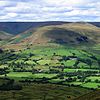| Higger Tor | |
|---|---|
 A millstone grit boulder on Higger Tor | |
| Highest point | |
| Elevation | 434 m (1,424 ft) |
| Coordinates | 53°20′02″N1°37′06″W / 53.3338°N 1.6183°W |
| Geography | |
| Location | Peak District, England |
| OS grid | SK 254 819 |
| Topo map | OS Landranger 110 |
Higger Tor or Higgar Tor is a gritstone tor in the Dark Peak, in the north of the Peak District National Park in England. It overlooks the Burbage Valley and the Iron Age hill fort of Carl Wark [1] to the southeast.
The tor stands to the south west of Sheffield, just within the city boundary, about 200 metres (220 yd) east of the border with Derbyshire, which runs along the nearby road to Ringinglow. The village of Hathersage is approximately 2 kilometres (1.2 mi) to the west.
A scene from the 1987 film The Princess Bride was filmed nearby at Carl Wark with Higger Tor visible in the background. [2]



